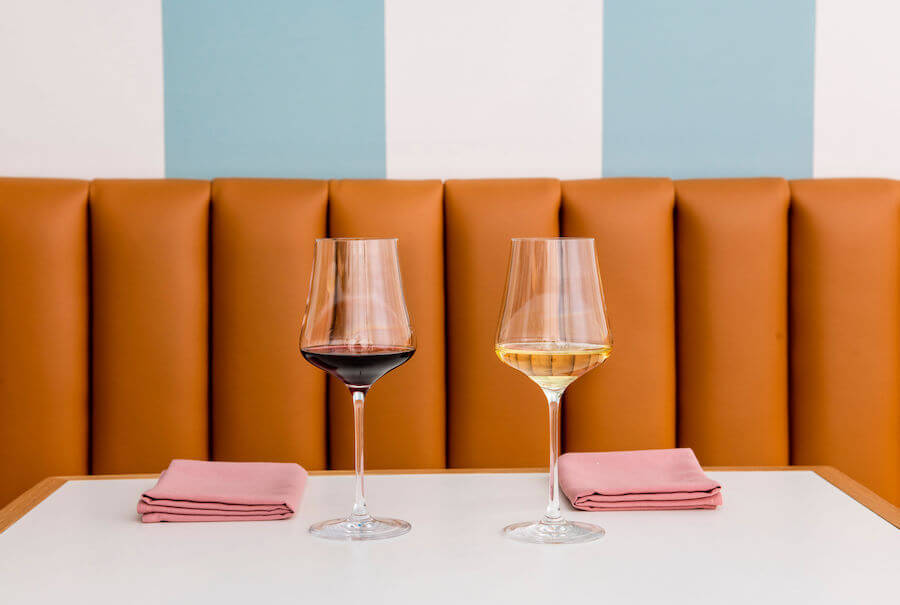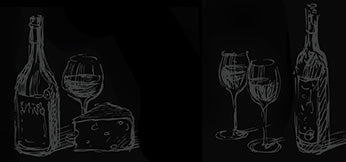At Gabriel-Glas, our stemware is strong by design—as a seamless glass, Gabriel-Glas is more durable than many other wine glasses on the market. Properly caring for crystal, however, will ensure that your wine will be served in a sparkling clean glass. There are a few important ways to keep your Gabriel-Glas stemware and stemless wine glasses looking fabulous and functioning flawlessly.
Glass Care & Use
Properly caring for crystal will ensure that your wine glasses look fabulous and function flawlessly.

Caring for crystal glassware is an important part of the wine-drinking experience.
Quick Care
Care & Use Guide
Jonah Beer, Principal & CEO demonstrates proper polishing
Keep your fine crystal looking brilliant
One of the easiest ways to break any wine glass is to polish it with the most common, incorrect method. Learn how to eliminate that breakage while keeping your glasses spotless and your hands safe.
How to Clean and Care for Your Crystal
We often get asked if Gabriel-Glas crystal glasses are dishwasher safe...and yes they are! All Gabriel-Glas glasses and decanters have been tested under EU standard EN-12875 which means they have been independently tested to withstand ordinary washing machine cycles with no degradation in brilliance and are resistant to common detergents. We recommend using an unscented, powdered detergent with a built in rinse aid when washing our dishwasher-safe crystal.
Even though our glasses are seamless and durable, they are not unbreakable. Most breakage occurs when loading the dishwasher, or when the glasses come into contact with other dishes during the wash cycle. For this reason we recommend that you load carefully (if your long dinner party has just ended, this step is best saved for the following morning!) and space the glasses out, on the top rack, so that they can’t make contact with one another or other dishes during the cycle.
At the end of the cycle when the glasses are still slightly damp or steamy is the best time to grab your Final Touch polishing cloth and give them a quick buffing to avoid water spots.
If you are hand washing your wine glasses use lukewarm water, a non-abrasive sponge or cloth, and a small amount of mild detergent. The key is to use mild detergent only where needed, like the bottom of the glass and around the rim. Be sure to get all the soap out of the glass with plenty of rinsing with lukewarm water. Soap residue left in the glass at this stage will taint your wine the next time you pour a glass of fine wine.
Are your Gabriel-Glas wine glasses looking a little foggy? Crystal wine glasses may develop a white or gray film over time and look cloudy. Very often the film is a result of water with high mineral content or hard water. Over time, red wine can cling to the bottom of the glass too. To remove water film or red wine from your crystal wine glasses, try soaking them in white vinegar, then wash with lukewarm water and a mild cleaning agent or run them through the dishwasher. Repeat as necessary until all of the residues are gone.
Another way to clean the inside of your wine glasses is to drop a tablet of Polident or Efferdent (yes, denture cleaner!) into the glass and add some hot water. Let them soak for 30 minutes or so and rinse until any scent is gone and give them a polish.
To keep your crystal wine glasses sparkling, we always recommend a polish after washing, or even to dust off your glasses just before serving. Use a microfiber polishing cloth like the Final Touch oversized polishing cloth to make it easier to handle the glass with both hands. The easiest time to polish a wine glass is right after you’ve washed it and before it has dried.
It is best to polish the bowl by cradling it like a baby’s head, then move to the stem, and finally the footplate. Never polish or wash a glass by holding the bowl in one hand, the stem in the other and twisting. This is the easiest way to break the glass and hurt yourself.
For a helpful step-by-step tutorial, check out this polishing video by our friends at Wine Folly.
Crystal wine glasses are more porous than normal wine glasses which means they are more likely to shelter residue and smells. To store your crystal wine glasses, they should be put in a well-ventilated area and if possible hung by their bases. Should you ever retrieve your glass and notice a faint odor from storage–cardboard smells, residual soap scent, or a mustiness from the cupboard–this is easily remedied by seasoning the glass with a bit of wine before service. See a how-to tip on that below.
Pointers, Tips & Tricks
As mentioned above, seasoning is a great trick for solving the ills of a soap-tainted glass, or a cupboard-scented decanter. A soapy or mildewy glass is a common oversight in restaurants where service is moving at warp speed and a short rinse, or a mildewy polishing cloth can leave behind an off putting odor. When you sniff an empty glass or decanter and detect the tell tale sign of mildew or soap, don’t despair, just do what the old-school pros do and season! Pour a small amount of wine–either the bottle you’re about to enjoy or another wine of matching color–into the first glass, swirl and roll the glass to coat the interior. Pour the residual wine into the next glass and repeat. Do this for all the glasses in question and dump the seasoning wine from the last glass into the sink. Viola! All your glasses are now ready for a proper pour. The same trick applies to a decanter that can often carry a “cupboard” smell because of the infrequency of use.
Both the Alpha Decanter and the DrinkArt Bottle are wonderful decanters for young and old wines alike. When decanting an young wine–the goal of which is to help open the bouquet and soften the palate–is to pour the wine into the decanter with a little velocity. Truth be told, we’re not fans of completely inverting the bottle, or aggressively sloshing it around, but a little briskness is a warranted when decanting a young Barolo, for instance. Regardless, the larger surface areas of the Alpha and the DrinkArt make them great choices for decanting young wines. The DrinkArt even has the added benefit of fitting into an ice bucket–a great advantage when decanting a white wine or champagne (and yes, it is often a good idea to decant young white wines and champagnes…seriously!).
Here, our goal is quite different from the reasons we decant a young wine. The Alpha Decanter is your tool of choice for this job. Open the mature wine and pour slowly into the shooter, back end of the Alpha. Pouring slowly allows you to leave behind, in the bottle, a majority of the sediment that has been thrown over time. Once the wine settles into the decanter you’ll have the chance to clarify it further with each pour. The long, slender, swan-like neck of the Alpha allows all the final sediment to fall out of suspension before reaching the glass. Also. Pouring an older wine from the Alpha Decanter is just about as cool as one can look!

